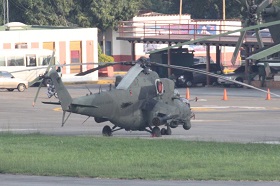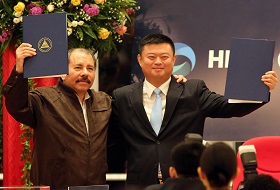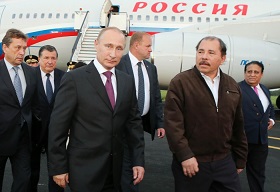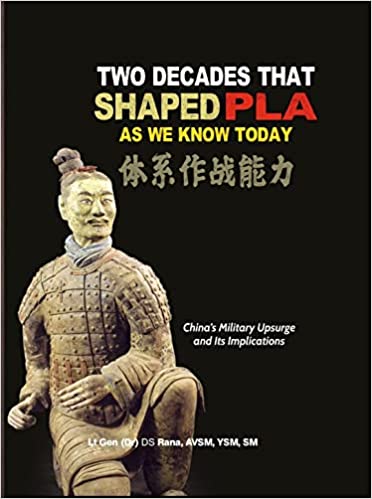At Commission on Military-Technical Cooperation (MTC) session with Foreign States on January 27, 2014 Russian President Vladimir Putin encouraged those present to seek out new markets, in particular mentioning Latin America. Soon afterwards, Defense Minister Sergey Shoigu paid a visit to Russia’s old friends in the region: Venezuela, Cuba and Nicaragua. The three countries’ leaders are known to have difficult relations with the United States, and are under U.S. trade restrictions, pushing them toward Russia and China. China’s economic position in the region is much stronger than Russia’s, so could China overshadow Moscow’s plans?
Venezuela: main theater of operations
The confrontation between Russia and China is most apparent on the Venezuelan arms market.
After coming to power in 1999, Venezuelan President Hugo Chavez headed for political rapprochement with Russia and China. This resulted in military-technical cooperation with Russia, but only really came into effect after the Americans imposed an embargo on the purchase of U.S.-made equipment. Having set the task of modernizing his country’s armed forces, Hugo Chavez began large-scale purchases of Russian weapons.
So, in recent years, Caracas has purchased Su-30MK2V fighters, Mi-17V5, Mi-26T2 and Mi-35M2 helicopters, T-72B1 tanks, Smerch multiple rocket launchers and S-300V anti-aircraft missile systems (NATO reporting name: SA-10 Grumble), Bal-E missile complexes (NATO reporting name: SSC-6 Sennight) for the Coast Guard, Nona-SVK self-propelled artillery vehicles, MSTA-S self-propelled howitzers, BTR-80A amphibious armored personnel carriers and Pechora-2M surface-to-air missile systems – all from Russia.
Cooperation in establishing joint ventures and technology transfers is also gaining momentum. The construction of a plant to manufacture AK-103 assault rifles under license and another to produce 7.62-mm ammunition for the rifles is nearing completion in Maracay.
In 2013, Venezuela signed an agreement to establish a helicopter service center.
Since 2005, Venezuela has concluded deals for Russian arms and military equipment valued at about $12 billion.
The supply of weapons under contract to the Bolivarian Republic is still ongoing, but the broader situation has changed. The possibility of signing new agreements in the near future is less likely. The Venezuelan authorities are looking to increase the number of suppliers and to diversify their purchases. The ongoing embargo has significantly narrowed the pool of potential suppliers while also strengthening the position of China's military products, making them an alternative to Russian weapons.
Venezuela concluded its first agreements with China about the same time that Russia started its deliveries under contracts previously concluded. In August 2005, a contract was signed with China Electronic Technology Group Corporation (CETC) for the purchase of three JYL-1 3-D long-range surveillance radars. In 2006, CETC was awarded a new contract worth $150 million for the purchase of seven JYL-1 surveillance radars and three JY-11B radars. Venezuela had received them all by the end of 2010.
Following a substantial break, in 2012 China’s Norinco signed a contract worth over $500 million for the supply of armored vehicles and artillery systems for the Marine Corps, in what was one of China’s largest known ground weaponry international deals. According to Chinese sources, Venezuela is to receive about sixty VN-1 8x8 amphibious fighting vehicles under this contract. In 2012, Venezuela began to receive the Chinese Shaanxi Y-8 tactical transport aircraft it purchased (in 2014 a total of eight aircraft had been delivered).
China was willing to help finance these transactions. In 2013 China allocated $36 billion to the Sino-Venezuelan cooperation fund, and some of this money will be spent on the weapons purchase.
Thanks to the loan, China was able to sell Venezuela its K-8 Karakorum light attack and jet trainer aircraft, although Venezuela under Hugo Chavez had shown interest in the Russian Yak-130 combat trainer (NATO reporting name: Mitten).
Over the past three years, cooperation between Venezuela and China has significantly intensified. In 2014 the commander of the Venezuelan Navy, Admiral Diego Molero Bellavia announced that approval had been given for an agreement with China on the purchase of eight anti-submarine helicopters to be used with the country’s Avante-type patrol ships. Most probably, these helicopters are Harbin Z-9 family helicopters, manufactured by China’s Harbin Aircraft Manufacturing Corporation.
In addition, the Venezuelan Navy is currently in talks with China on the repair and modernization of the three Lupo-class frigates built in Italy.
Venezuela’s pivot to China is due not only to these generous loans. After-sales service has been a key factor and has historically been a weak spot in the Russian arms trade. As to the Russian equipment supplied to Venezuela, there were problems with logistics support for the Su-30 fighters, and there were some design flaws of the Mi-35M attack helicopters. This caused flights to be postponed and Venezuela had to invest additional funds in their repair.
China pays much more attention to its after-sales service system. According to Venezuelan sources, it was the fact that China’s after-sales service provision was more developed than Russia’s that was a key factor in Venezuela choosing Chinese ground equipment over the Russian alternatives.
Cuba: A quarter century in ambush
Cuba used to be the springboard for the spread of Soviet weapons through Latin America: local revolutionaries were armed with them. But Chinese have always been nearby. Maoism found supporters across the region, and China supplied them with products from its then incipient military industry, which then produced low-quality replicas of Soviet and American weapons.
Having supplied Cuba with weapons and military equipment worth $16 billion from 1961 to 1991, the USSR turned a small island country into a militarily strong power with, perhaps, the best army in Latin America in the early 1990s.
Now, after nearly a quarter century, the combat equipment of the Cuban revolutionary armed forces can be hardly called modern. It was a difficult time for the Island of Freedom. The Helms-Burton Act passed by the U.S. Congress in 1996, imposing sanctions against foreign companies trading with Cuba, is a vivid illustration of this. Against this backdrop, selling arms to Havana openly was very risky.
We can only guess how the Cuban authorities skirted the ban, in view of the incident with the North Korean vessel in the summer of 2013 and accusations of China sending secret arms shipments to Havana sparked by the rumor that “at least three arms shipments were traced from China to Cuba”, which appeared in the American press in 2000. At that time Beijing did not issue any denials. Chinese spokesman Zhang Yuanyuan said that China “supplied the Cuban military with logistics items – never arms.” Asked if explosives were included, he explained that “explosives could be used for both civilian and military purposes.” So, the Cuban Armed Forces entered the 21st century with the help of its own military industry, Chinese “logistics items” and North Korean upgrades.
Where was Russia? Russia voluntarily “disappeared” as far as Cuba was concerned in 1991. The relationship, including in military-technical cooperation, has recently begun to recover. In 2006, a Rosoboronexport delegation visited Cuba and signed a “number of documents on military-technical cooperation.” Soon the countries exchanged visits: in late 2008 President Dmitry Medvedev visited Havana, and in early 2009 President of the Council of State and the Council of Ministers of Cuba Raul Castro came to Moscow. During the visit, a memorandum was signed on the principles of strategic cooperation between the two countries, mentioning the development of military-technical cooperation.
During his visit to Cuba, head of the Federation Council’s Defense and Security Committee Viktor Ozerov half-opened the veil of secrecy over the talks. He told the media that Cuba was interested in military-technical cooperation with Russia, and in particular highlighted personnel training, which was “actively carried out by the Defense Ministry,” and plans to modernize the armed forces of Cuba, which “could involve the supply of military equipment on credit.”
In the course of these summits it is likely that discussions began on the construction by Russia of an ammunition plant, details of which appeared in the Russian media only in 2011. Commenting on this in December 2011, Deputy Director of the Federal Service for Military-Technical Cooperation (FSMTC of Russia) Konstantin Biryulin said that the equipment had been supplied a long time ago and “the case in point was just getting it out of the boxes.”
Since then, there has been no new information about any high-profile contracts with Cuba, and according to official statistics, in 2013, Russia supplied weapons and ammunition worth $197.7 thousand to Havana.
China, like Russia, prefers to soft-pedal its military-technical cooperation with Cuba. Mentions of it in the media could harm trade. China’s military continue to visit Cuba and talk about cooperation in training.
China’s trade turnover with Havana amounts to about $1.8 billion and is expected to increase by 25% in 2015. Russia’s was just $185.1 million in 2013. China is interested in cooperation, including military cooperation, with Cuba because of the construction of a canal in Nicaragua, while Russia has no such plans in the region yet. Nevertheless, in 2014 the Russian government took action – 90% of debt to the USSR ($32 billion) was cancelled. What can the Russian government expect after such a gesture? Perhaps it will somehow retain a foothold in Cuba, the key to the Caribbean. But a lot of time has been lost, and Cuba is now the site of a struggle between the United States and China. However, Dmitry Rogozin, who visited Havana in late December 2014, inspired some optimism by saying that certain agreements, for which “the time has come” had been signed. Intriguingly, this came right after the U.S. announcement that relations with Cuba were to be restored.
The confrontation between Russia and China over Cuba could turn into a joint U.S. deterrence. An independent Cuba is in the best interests of both Russia and China, and military-technical cooperation with that state does not promise major economic benefits. According to the World Bank, Cuba spends only 3.3% of its GDP on military purposes on a regular basis, which is roughly $2.25 billion.
Nicaragua: Canal controversy
Against the background of Moscow’s numerous statements on cooperation with the countries of Latin America and its less than active development in reality, the media often fills this gap – making it seem like there is more activity than there is in reality. It has been reported that Russia is going to deliver to Nicaragua eight MiG-29 jet fighter aircraft (NATO reporting name: Fulcrum). The cost of the MiG-29 fighter is about $30 million, while the entire GDP of Nicaragua is about $11 billion. The denial of this information by the Nicaraguan Ministry of Defense would have been quite convincing, if the TASS news agency hadn’t revealed the same news on 10 February 2015. Brigadier General Adolfo Zepeda Martinez said that the MiG-29 fighters would be purchased for “defense purposes,” adding that the purchase of Russian naval patrol ships was also under consideration. Where Nicaragua gets the money for this we can only guess.
However, this “enrichment” of the Central American state could be due the fact that in November 2014 the Russian government instructed the Foreign Ministry and the Defense Ministry to negotiate a simplified procedure for the entry of Russian warships into the Nicaragua’s ports, which was agreed upon during Sergey Shoigu’s last visit.
The overall level of military-technical cooperation between the two countries remains low, and so far has included the supply of equipment for the local drug police, the construction of a plant for the disposal of ammunition (2013), delivery of five engineer vehicles, two Project 12418 missile boats (code “Lightning”) and four Project 14310 Coast Guard patrol boats (code “Mirage”). However, observers also note the unexpected modernization of Nicaragua’s in-service equipment and even the appearance of new units in the parade in fall 2014.
All these developments cannot but suggest that they are related to the construction of the canal in which Chinese businessmen have invested about $50 billion. This canal is a strategic object requiring protection that the armed forces of Nicaragua cannot provide in their current state. Moreover, China has no diplomatic ties with Managua (Nicaragua recognizes Taiwan). Thus, cooperation between China and Russia would be more than logical.
This opinion is shared by Taiwan’s Want ChinaTimes, which indicates that Russia’s involvement in the project could take the form of military support to ensure safety at least during the construction process. We will know soon enough, if this is the case. After all, Vladimir Putin must have had some reason to visit Managua in summer 2014, although Russia’s trade turnover with Nicaragua is less than $100 million.
In this respect, it is worth noting the opinion on Russia's role in the history of the canal expressed by Vladimir Evseev, Director of Russia's Center for Social and Political Research. “We [Russia and China] are both interested in restraining the U.S.," said he. "The problem is, China does not want to make unnecessary trouble. Russia on the other hand is more independent.”
At the moment, China and Russia have every opportunity to influence the security system in the Caribbean due to their special relationship with its three most important states.
At the same time, Russia’s current potential to build up economic ties is significantly inferior to that of China. However, Russia still enjoys the advantage of the technological backlog made by the Soviet Union. This allowed us to outpace China in the arms market of Venezuela. At the same time the overall level of economic relations allows China to systematically build up its military-technical cooperation, forming an integrated approach to technological cooperation with an eye to the future. To meet this challenge, Russia needs to improve marketing mechanisms, enhance technological and economic cooperation beyond the military-technical, fully exploiting and maintaining its fading technological superiority.










